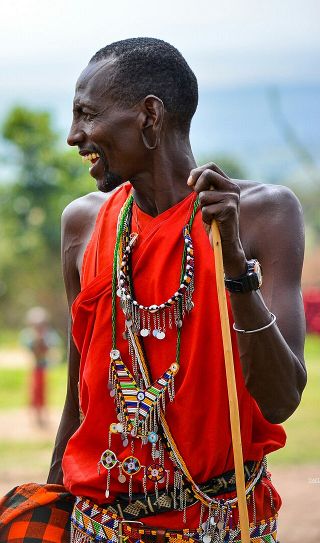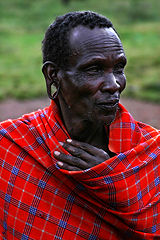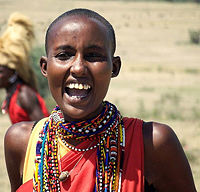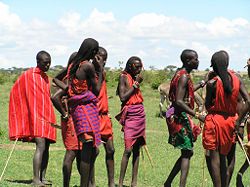Maasai
| Maasai | ||||||
|---|---|---|---|---|---|---|
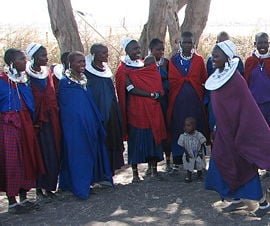
| ||||||
| Total population | ||||||
| 1,297,000[1] | ||||||
| Regions with significant populations | ||||||
| ||||||
| Languages | ||||||
| Maa (…Ēl Maa) | ||||||
| Religions | ||||||
| Monotheism Christianity | ||||||
| Related ethnic groups | ||||||
| Samburu |
The Maasai are an indigenous African ethnic group of semi-nomadic people located in Kenya and northern Tanzania. Due to their distinctive customs and dress and residence near the many game parks of East Africa, they are among the most well-known African ethnic groups internationally. They speak Maa a Nilo-Saharan language related to Dinka, Nuer, Turkana, and Songhai. The Maasai population has been estimated as 841,622 in Kenya with a total population of over 1 million. Estimates of the respective Maasai populations in both countries are complicated by the remote locations of many villages, their semi-nomadic nature and their being the only ethnic group allowed free travel over the Kenyan-Tanzanian border.
Maasai are pastoralist and have resisted the urging of the Tanzanian and Kenyan governments to adopt a more sedentary lifestyle. They have demanded grazing rights to many of the national parks in both countries and routinely ignore international boundaries as they move their great cattle herds across the open savanna with the changing of the seasons. This resistance has led to a romanticizing of the Maasai way of life that paints them as living at peace with nature. For the Maasai to find their place in the larger human world, there needs to be a balance between their traditional lifestyle and beliefs, and more universally acceptable cultural norms.
History
According to Maasai oral history, they originated from the lower Nile valley north of Lake Turkana (southern Sudan) and began migrating south around the fifteenth century, arriving between the seventeenth and late eighteenth century. Other ethnic groups were forcibly displaced as they settled in a long trunk of land stretching from northern Kenya to central Tanzania.[3]
The Maasai territory reached its largest size in the mid-nineteenth century, and covered almost all of the Rift Valley and adjacent lands from Mount Marsabit in the north to Dodoma in the south.[4] At this time the Maasai, as well as the larger group they were part of, raided cattle as far east as the Tanga coast in Tanzania. Raiders used spears and shields, but were most feared for throwing clubs which could thrown accurately up to 70 paces. In 1852 there was a report of a concentration of 800 Maasai warriors on the move in Kenya. In 1857, after having depopulated the ‚ÄúWakuafi wilderness‚ÄĚ in southeastern Kenya, Maasai warriors threatened Mombasa on the coast of Kenya. Because of this migration, the Maasai are the southernmost Nilotic speakers.[5]
The period of expansion was followed by the Maasai "Emutai" of 1883-1902. This period was marked by epidemics of Contagious bovine pleuropneumonia, rinderpest, and small pox. The estimate first put forward by a German lieutenant in what was then northwest Tanganyika, was that 90 percent of cattle and half of wild animals perished from rinderpest. German doctors in the same area claimed that ‚Äúevery second‚ÄĚ African had a pock-marked face as the result of smallpox. This period coincided with drought. Rains failed completely in 1897 and 1898.[6]
The Austrian explorer Oscar Baumann traveled in Maasailand in 1891-1893, and described the old Maasai settlement in the Ngorongoro Crater in the 1894 book ‚ÄúDurch Massailand zur Nilquelle‚ÄĚ (By Massailand to the Source of Nile):
There were women wasted to skeletons from whose eyes the madness of starvation glared … warriors scarcely able to crawl on all fours, and apathetic, languishing elders. Swarms of vultures followed them from high, awaiting their certain victims.
By one estimate, two-thirds of the Maasai died during this period.[7] The Maasai stood against slavery and lived alongside most wild animals with an aversion to eating game and birds. Maasiland now has East Africa's finest game areas. Maasai society never condoned traffic of human beings, and outsiders looking for people to enslave avoided the Maasai.[8]
Starting with a 1904 treaty,[9] and followed by another in 1911, Maasai lands in Kenya were reduced by 60 percent when the British evicted them to make room for settler ranches, subsequently confining them to present-day Kajiado and Narok districts.[10] More land was taken to create wildlife reserves and national parks (Amboseli, Nairobi National Park, Maasai Mara, Samburu, Nakuru, Manyara, Ngorongoro, Serengeti, and Tsavo).
Culture
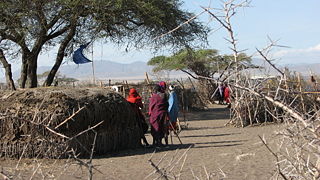
The Maasai speak Maa, an Eastern Nilotic language. It is closely related to the other Maa varieties Samburu (or Sampur), the language of the Samburu people of central Kenya, Chamus, spoken south and southeast of Lake Baringo (sometimes regarded as a dialect of Samburu); and Parakuyu of Tanzania. The Maasai, Samburu, il-Chamus and Parakuyu peoples are historically related and all refer to their language as …Ēl Maa.
Maasai society is patriarchal in nature with the elders deciding most matters for each Maasai group. The laibon or spiritual leader acts as the liaison between the Maasai and God, named Enkai or Engai, as well as the source of Maasai herblore. The Masaai are mostly monotheistic in outlook, but many have become Christian under the influence of missionaries. Traditional Maasai lifestyle centers around their cattle which constitutes the primary source of food. They also believe that God gave them his cattle to watch over. Women can only marry once in a lifetime, although men may have more than one wife (if enough cows are owned, they may have more than one at a time).
Cattle wealth
Traditionally, the Maasai measure a man's wealth in terms of cattle and children rather than money - a herd of 50 cattle is respectable, and the more children the better. The main staple to Maasai life and culture is cattle.[11] For hundreds of years the Maasai have lived sustainably through grazing their herds. Cattle are the traditional staple of Maasai diet, which used to consist of meat, milk and blood, and also are tightly intertwined in Maasai economy, social structure, religion, and relationships. Herd size has always been a way to distinguish the rich from the poor and have long been the bond between many social and personal bonds. Upon marriage tradition constitutes the bride price of cattle and upon social disputes cattle have been used for trading or reconciliation. Of equal importance is the use of cattle slaughtering in religious transitional ceremonies for boys. As boys move up to the status of men a cow is slaughtered as an offering, marking their completion into the next chapter of their lives. For the Maasai, cattle have always been an integral part of culture and survival.[11][4]
The Maasai are indigenous to North Central Tanzania and Southern Kenya. In old traditional Maasai stories it is said that the Maasai journeyed from Northern Africa in search of fertile grasses to feed their cattle. Their cattle were dying and consequently they did not have enough food to feed their children. The elders knew that they must move their people to a more prosperous place, but they had no idea where to go. Upon turning to nature to provide them with answers, they saw a bird land in a bare tree with green grass in its beak and work on building a nest. They watched the bird as it flew over the horizon and up into the cliffs. The elders sent a few boys to go climb that cliff and see what was beyond it. The boys did so and they came back with the news that they had seen a green and lush land with rivers, green trees, and rich grasses. The Maasai then decided that they would move to the other side of the cliffs. A giant ladder was built and the entire village, people and cattle alike, began to climb their way up in hopes of a better life. Half the population had reached high ground when the ladder collapsed. The people up on the cliff's edge knew there was nothing they could do for those left behind. They began a new life and prospered in the new land; they were the Maasai and that is how they came to be separate from other peoples.[12] This is an important story in Maasai oral culture, reflecting how they feel they became a people.
As a historically nomadic and then semi-nomadic people, the Maasai have traditionally relied on local, readily available materials and indigenous technology to construct their housing. The traditional Maasai house was in the first instance designed for people on the move and was thus very impermanent in nature. The Inkajijik (Maasai word for a house) are either loaf-shaped or circular, and are constructed by women. The structural framework is formed of timber poles fixed directly into the ground and interwoven with a lattice of smaller branches, which is then plastered with a mix of mud, sticks, grass, cow dung and urine, and ash. The enkaji is small, measuring about 3m x 5m and standing only 1.5m high. Within this space the family cooks, eats, sleeps, socializes, and stores food, fuel, and other household possessions. Small livestock are also often accommodated within the enkaji.[13] Villages are enclosed in a circular fence (Enkang) built by the men, usually of thorned Acacia. At night all cows and goats are placed in an enclosure in the center, safe from wild animals.
The Tanzanian and Kenyan governments have instituted programs to encourage the Maasai to abandon their traditional semi-nomadic lifestyle and adopt an agrarian lifestyle instead.
Body art and modification
The piercing and stretching of earlobes has been common among the Maasai.
The removal of deciduous canine tooth buds in early childhood is a practice that has been documented in the Maasai of Kenya and Tanzania. There exists a strong belief among the Maasai that diarrhoea, vomiting, and other febrile illnesses of early childhood are caused by the gingival swelling over the canine region, and which is thought to contain 'worms' or 'nylon' teeth. This belief and practice is not unique to the Maasai. In rural Kenya a group of 95 children aged between six months and two years were examined in 1991/1992; 87 percent were found to have undergone the removal of one or more deciduous canine tooth buds. In an older age group (3-7 years of age), 72 percent of the 111 children examined exhibited missing mandibular or maxillary deciduous canines.[14] [15]
Young men cover their bodies in ochre to enhance their appearance. Also warriors spend ample time completing ornate hairstyles. Young men can also be seen scarring their bodies with heated spears in order to show bravery.
Beadwork is also important in Maasai body ornamentation. Complex bead patterns cover discs that hang around their necks. The patterns may be used to determine an age set or hierarchy in the tribe. Typically woman and young girls partake in the beadwork.
Female mutilation
Young girls undergo Female genital cutting (FGC) in an elaborate rite of passage ritual in which they are given instructions and advice pertaining to their new role, as they are then said to have come of age and become women, ready for marriage. These circumcisions are usually performed by a hired local expert without anaesthetic using crude knives, glass or other sharp implements available for as much as US $6.00 per girl. Girls are married off early, sometimes as young as seven years old. The practice of FGC draws a great deal of criticism from both abroad and many women who have undergone it, and in some cases has recently been replaced by a "Cutting with words" ceremony involving singing and dancing in place of the mutilation. However, the practice remains deeply ingrained and valued by the culture, as well as being held as necessary, since Maasai men typically reject any woman who has not undergone it as either not marriageable or worthy of a much-reduced bride price.[16] FGC is illegal in both Kenya and Tanzania.[17][18]
Diet
Traditionally, the Maasai diet consisted of meat, milk, and blood from cattle. However, the inclusion of blood in the traditional diet is waning due to the reduction of livestock numbers. More recently, the Maasai have grown dependent on food produced in other areas such as maize meal, rice, potatoes, cabbage (known to the Maasai as goat leaves), and such like. The Maasai who live near crop farmers have engaged in cultivation as their primary mode of subsistence. In these areas, plot sizes are generally not large enough to accommodate herds of animals; thus the Maasai are forced to farm.[13]
Clothing
Many Maasai in Tanzania wear simple sandals, sometimes soled with pieces of motorcycle tires. Both men and women wear wooden bracelets. The Maasai women regularly weave and bead jewelery. This bead work plays an essential part in the ornamentation of their body. A main article of Maasai clothing is a wrap, the women's wraps are called kanga and the men's are called kikoi. The tribe usually incorporates some form of red in to their attire. Some believe that red is a special color to them because the tribe traditionally created the color for their shields by mixing the clay with the red sap of the solanum campylae fruit or cattle blood. The Maasai’s red clothing is also believed to stand for power. The men color their hair red with clay and red ocher which is a pigment found in natural form in volcanic regions.
Warriors
The Morani are the great protectors of the Maasai community. These warriors are known for being brave and pround. When the Maasai are young men, around the age of 15, they learn to become Morani. They are not allowed to travel or eat alone in hope to teach them to work as a group. The young Morani hunt lions as a way of proving themselves brave warriors. These warriors are recognized by their painted faces as well as their headdresses which are made out of feathers and wood. In order to increase their bravery the warriors drink a special narcotic made from the bark of the thorny olkiloriti tree.
Within the Morani are two groups, seniors and juniors. Junior warriors are called Ilkiliyani. They are recognized by the handles on their wooden handled spears and by their short hair. Their hair is short because warriors will have their heads ceremoniously shaved following the circumcision ceremony into manhood. Following the ceremony the warriors let their hair grow long. Many hours are spent by warriors braiding each others’ hair. The long hair style is designated only for warriors in the tribe. Senior warriors are called Ilingeetiani. They are recognized by their ebony handled spears and long braided hair. Warriors that spear a lion early in their training are the most respected. They then wear the lion’s mane as a head piece in some ceremonies to exhibit their bravery.
Music
Music of the Maasai is purely instrumental with the exception of the Eunoto ceremony where a kudu horn is incorporated. The music is based on a call and response format involving the guttural polyrhythms of the warriors and the participation of the community. Most ceremonies are around the season of the rains in which rite of passage such as circumcision and marriage take place. The performances are in public where women can join off to the side. Rarely are women allowed in to the Morani dance. If it is allowed it can be a way for the Morani to flirt.
The format of the ceremonies include the Morani standing in a circle or a line performing the adumu or aigis, meaning ‚Äúto jump.‚ÄĚ The Morani dance includes warriors jumping solo as high as possible in front of the tribe. Simultaneously others are swaying their bodies back and forth. As soon as a warrior tires, typically after one or two leaps, another warrior takes his place. Another common movement in Morani dance involves the neck. Neck movements differ during the ceremony while jumping, dancing, sitting or standing. The head position relies on the whether the singer is breathing in or out. When breathing out the head is leaned forward and when breathing in the head is tilted back. The music incorporated consists of a deep rhythm created by grunts. Everyone involved has a part that has allowance for ornamentation. Members of the group may raise the pitch of their voices based on the height of the jump.
An olaranyani is a song leader that starts each song with a namba. Nambas form the beginning of the song through the means of an olaranyani singing a line or the title of the song. The other members of the ceremony then respond in recognition to the olaranyani. Several singers may lead a song; each singer will start his or her verse with a namba. The songs lyrics usually follow a theme and commonly are repeated throughout the song. Women ceremonial song is normally sung in a call-and-response pattern. Women are not likely to include throat singing in their music. Most of the females’ songs are homophonic melodies that are used as lullabies and milking songs. Typically the singer responds to their own verses and repetition of phrases is common.
Mythology
The supreme being and creator is known as Enkai (also called Engai), and serves as the guardian over rain, fertility, love and the sun. It was Enkai who gave cattle to the Maasai people. Neiterkob is a minor deity, known as the mediator between God and man. Olapa is the Goddess of the Moon, married to Enkai. The myth is that they were fighting one day when Olapa, being a short-tempered woman, inflicted Enkai with a grievous wound. To cover up his wound, he cast a spell which enabled him to shine so brightly, that no one could look straight at him and see his shame. Enkai then took his revenge by hitting Olapa back and striking out one of her eyes. This can be seen today, when the moon is full.
Contemporary issues of the Maasai
The current Maasai population is roughly one million people and they live in the Great Rift Valley of East Africa; North central Tanzania and Southern Kenya. Essentially there are twelve geographic sectors of the tribe, each one having its own customs, appearance, leadership, and even dialects. These subdivisions are known as the: Keekonyokie, Damat, Purko, Wuasinkishu, Siria, Laitayiok, Loitai, Kisonko, Matapato, Dalalekutuk, Loodokolani and Kaputiei.[19]
The picture of Maasai culture and lifestyle is very quickly being distorted. Tradition is challenged and many times overthrown by a lack of customary resources. Time-honored practices have little chance for survival within the context of rapid western influence. Everything is threatened. No longer are the times where the Maasai can maintain a cattle centered lifestyle. Kenyan and Tanzanian governments, along with some conservationist groups, have come close to eradicating the Maasai way of life. Traditional means of sustenance, medicine, water, and education have been labeled as inefficient by western influences and newly empowered Kenyan and Tanzanian governments. Due to changes in political structure the Maasai are facing devastating issues, the most pertinent being Maasai land allocation, wildlife preservation, disease, poverty, lack of education, no healthcare, and lack of clean and safe drinking water. These issues are all tightly intertwined and endlessly complex; altering cultural practices, shifting traditional power dynamics, redefining survival essentials and threatening lives.
The most unexpected threat to the Maasai is the lack of clean drinking water. Maasailand is located in an ideal position to benefit from the largest water resources in Kenya, the Kilimanjaro Water Development, whose pipelines actually cut right through Maasai territory itself. Water is diverted out into to Machakos, Makueni district, and Athi-River Town, leaving the Maasai people unnerved. Only the wealthiest of the Maasai can afford to divert any water, leaving almost all Maasai to fight disease, hunger, and poverty without this precious, and ironically very local, resource that can be of fundamental use to exponentially improve the quality of life for all Maasai.
Conservation projects, such as the Waterhole Conservation Project in the Merrueshi Group Ranch, are working to improve the situation by restoring waterholes that have historically been the primary source of water in the semi-arid land of the Maasai. To date, watering holes continue to play an important role for wildlife and livestock in East Africa. According to Maasai pastoralists, the waterholes were originally formed and maintained by elephants and warthogs. However they became damaged by the effects of prolonged drought. Restoration benefits both the pastoralists and the wildlife, by retaining seasonal rainwater.[20]
Many groups of indigenous people from around the world are dealing with issues of sustainability. Traditional lifestyles often clash, to some degree, with an attempt to stay active and participatory in the growing global economy. For the Maasai, small scale practices are being pushed aside to make way for western expansion. The Maasai are caught between a desire to maintain their cultural traditions and their need to adapt to a changing social, political and economic background. Due to influence from other cultures (mostly western), the traditional Maasai way of life is increasingly threatened. Over the years, many projects have begun to help Maasai tribal leaders find ways to preserve their traditions while also balancing the education needs of their children for the modern world. The emerging forms of employment among the Maasai people include farming, business (selling of traditional medicine,running of restaurants/shops, buying and selling of minerals, selling milk and milk products by women, embroideries), and wage employment (as security guards/ watchmen, waiters, tourist guides), and others who are engaged in the public and private sectors.
Sickness and disease
In villages of southern Kenya, the nearest clinic is over 60 miles away. Most of the sick can not afford to make this journey and many that try do not survive. Maasai have traditionally been able to take care of themselves through the use of traditional herbal medicine, but their modern sedentary lifestyle often prohibits them from being able to have access to traditional medicines. Furthermore Maasai people and cattle have fallen ill due to diseases brought upon by western colonization. It used to be standard practice of the Maasai to graze their cattle at night, as to avoid the dangerous disease-laden tsetse flies, but with grazing land being converted into game reserve areas, areas that had been free of flies in the past had become unsuitable for grazing. What were once safe lands to travel across now turned into dangerous hosting grounds for these disease carrying insects. Cholera is another disease prevalent within Maasailand, completely preventable, if the Maasai had access to the Kilimanjaro Water Development, hundreds are dying from drinking unsafe contaminated water. Also prevalent in Kenya are tuberculosis, malaria, HIV, and trachoma.[21] Many Maasai members are unaware that all of these diseases should be preventable or treatable to some extent.
Lack of education and poverty
The Maasai are not rigid and opposed to learning about the western ways that have been imposed upon them. To the contrary, most Maasai feel that some change in inevitable and welcome the education as a means to better understand and act within the Kenyan and Tanzanian governments that rule so many aspects of their lives and culture. Maasai leaders are eager to see a progress is made, but they have strong obstacles to overcome. There are very few schools in Maasai region and no colleges. There is no investment into the children of Maasai; government leaders live a lavish lifestyle while their privileged children are sent to get a proper education overseas. The Maasai have become the underprivileged and often overlooked minority group. Kenyan and Tanzanian governments have done little in the way of supporting Maasai culture. As more land is being taken away, and more conditions are being placed on government aid, the Maasai are faced with the difficulty of having to navigate an entirety new sociopolitical system with very little education to understand it.
Land allocation and wildlife preservation
The Maasai currently inhabit just a fraction of the land in which they once had free reign.[22] Their land has been confiscated for mass agricultural purposes and wildlife conservation. Conservationists have depicted them as incompatible with nature and consequently much of their land has been taken way from them in order to make way for animal reserves.[23] Although seemingly well-intentioned, Game Parks and reserves are a cause of great stress and injustice for the Maasai. Upon implementation of these reserves and promotion of ecotourism the Maasai were completely left out of the equation. The Maasai have been living with the land, as opposed to off the land, for hundreds of years. They have a profound knowledge of wildlife, trees herbs, roots, grasses and other plants in their country. They have long been utilizing all of their natural resources for medicinal purposes, both for themselves and their livestock. Despite evidence that Maasai pastoralism has no negative effects on nature their traditional ways of life have been challenged by limited access to traditional lands uses, they are losing some of their best land and being pushed into drier areas.[24] Due to increased emphasis on wildlife preservation many Maasai have been forced to convert to a more western way of live. Maasai herd sizes have shrunk significantly and many Maasai are now involved in agriculture. This western imposed sedentary lifestyle has proven to yield insufficient food for the Maasai and has left the land overused and eroded. The seasonal climatic shifts and poor soil quality of most of Maasailand have proven to be far more favorable for traditional Maasai sustenance methods of pastoralism. Western impositions have put the Maasai in a position of poverty, famine and economic duress.[22]
Although the prognosis seems grim for the Maasai, the fact still remains that they have proven to be a strong and vibrant culture that can and have tackled many adversities. There are programs implemented to empower the Maasai to force a change in their best interest. A culture known as warriors, the Maasai will continue to work hard towards the survival of not only their people, but their culture as well.
As a result of the many twenty-first century issues that are plaguing the Maasai many support groups have been founded. Organizations work in collaboration with rural non-governmental organizations (NGOs) to implement sustainable solutions for community survival, education, and growth. They aim to "empower local people, rely on indigenous resources, and build upon their existing cultural and economic context."[25]
Notes
- ‚ÜĎ Maasai Ethnologue. Retrieved June 4, 2013.
- ‚ÜĎ 2009 Population & Housing Census Results Retrieved June 4, 2013.
- ‚ÜĎ Maasai History Retrieved December 16, 2007.
- ‚ÜĎ 4.0 4.1 Phillip Briggs, Northern Tanzania with Kilimanjaro and Zanzibar (Bradt Travel Guides, 2006, ISBN 1841621463).
- ‚ÜĎ Toyin Falola and Christian Jennings, Sources and Methods in African History: Spoken Written Unearthed (Boydell & Brewer, 2003, ISBN 1580461344), 182.
- ‚ÜĎ Blackwell Publishing Impact of Climate Change in Africa. November 24, 2006.
- ‚ÜĎ Rinderpest Retrieved December 16, 2007.
- ‚ÜĎ Nigel Pavitt, Africa's Great Rift Valley (New York, NY: Harry N. Abrams, Incorporated, 2001, ISBN 0810906023), 122.
- ‚ÜĎ Stefan Faris, "The Land Is Ours" TIME magazine, Sept. 19, 2004. Retrieved December 16, 2007.
- ‚ÜĎ History of the Maasai.
- ‚ÜĎ 11.0 11.1 Lisa Mathews, "The Battle for Cattle," Cultural Survival Quarterly 2006.
- ‚ÜĎ Tiyambe Zeleza, Maasai (New York, NY: The Rosen Publishing Group, 1994, ISBN 978-0823917570).
- ‚ÜĎ 13.0 13.1 Maasai Association. Maasai People Retrieved December 16, 2007.
- ‚ÜĎ J. Hassanali, P. Amwayi, and A. Muriithi, Removal of deciduous canine tooth buds in Kenyan rural Maasai East Afr Med J. 72(4) (April 1995): 207-209. Retrieved December 16, 2007.
- ‚ÜĎ J. F. Hiza and E. N. Kikwilu, Missing primary teeth due to tooth bud extraction in a remote village in Tanzania. Int J Paediatr Dent. 2(1)(April 1992) :31-4. Retrieved December 16, 2007.
- ‚ÜĎ Razor's Edge - The Controversy of Female Genital Mutilation IRIN Humanitarian News and Analysis, UN Office for the Coordination of Humanitarian Affairs March 2005.
- ‚ÜĎ Tanzania fails to enforce law against female genital mutilation Retrieved December 16, 2007.
- ‚ÜĎ The Abolition of Female Genital Mutilation Retrieved December 16, 2007.
- ‚ÜĎ Culture Facts Retrieved December 16, 2007.
- ‚ÜĎ Waterhole Restoration Project Maasai Association. Retrieved December 16, 2007.
- ‚ÜĎ Sam Crowe, "The Maasai Move to Eliminate Trachoma" British Medical Journal (1997).
- ‚ÜĎ 22.0 22.1 Eugene Hillman, "The Pauperization of the Maasai in Kenya," Africa Today (1994)
- ‚ÜĎ D. Schaffer, M. Eshan, Y. Ndege, P. Bagla, and K. Mantell. "Dry: Life Without Water" Environment 8(11) (Jan-Feb 2007).
- ‚ÜĎ K. Kimani and J. Pickard, "Recent Trends and Implications of Group Ranch Sub-Division and Fragmentation in Kajiado District, Kenya" The Geographical Journal (1998).
- ‚ÜĎ Village Volunteers Retrieved December 16, 2007.
ReferencesISBN links support NWE through referral fees
- Briggs, Phillip. Northern Tanzania with Kilimanjaro and Zanzibar. Bradt Travel Guides, 2006. ISBN 1841621463
- Conroy, Ronan. Solar Disinfection of Drinking Water and Diarrhea in Maasai Children: A Controlled Field Trail. 1996.
- Craats, Rennay. Maasai (Indigenous Peoples). New York, NY: Weigl Publishers, 2005. ISBN 978-1590362198
- Crowe, Sam. "The Maasai Move to Eliminate Trachoma" British Medical Journal (1997).
- Falola, Toyin and Christian Jennings. Sources and Methods in African History: Spoken Written Unearthed. Boydell & Brewer, 2003. ISBN 1580461344
- Fedders, Andrew, & Cynthia Salvadori. Peoples and Cultures of Kenya. Nairobi: Transafrica, 1979.
- Finke, Jens. Maasai ‚Äď Music and Dance: Tradition Music and Cultures of Kenya BlueGecko.org. 2003. Retrieved Jan 23, 2007.
- Galaty, John. Being "Maasai": Ethnic Shifters in East Africa American Ethnologist (1982).
- Gordon, Raymond G., Jr. (ed.), 2005. Ethnologue: Languages of the World, Fifteenth edition. Dallas, Tex.: SIL International.
- Groom, Debra. Maasai Make Tully School Aid Effort Come Alive: Kenyans Highlight Their Culture and Problems Their Community Face The Post Standard, 2006. Retrieved January 23, 2007.
- Hillman, Eugene. "The Pauperization of the Maasai in Kenya," Africa Today (1994).
- Hodgson, Dorothy. Once Intrepid Warriors: Gender, Ethnicity, and the Cultural Politics of Maasai development. Bloomington, IN: Indian University Press, 2004. ISBN 978-0253214515
- Johnson, Hans. Culture 2004. Retrieved January 23, 2007.
- Kimani, K. and J. Pickard. "Recent Trends and Implications of Group Ranch Sub-Division and Fragmentation in Kajiado District, Kenya" The Geographical Journal (1998).
- Kipury, Naomi. Oral Literature of the Maasai. Nairobi, Kenya: East African Educational Publishers Ltd., 1983.
- Little, Peter D. "Maasai Identity on the Periphery" American Anthropologist (1998).
- Maasai Information: Art and Life in Africa Online 1998. Retrieved March 27, 2007.
- Mathews, Lisa. "The Battle for Cattle," Cultural Survival Quarterly (2006).
- Pavitt, Nigel. Africa's Great Rift Valley. New York, NY: Harry N. Abrams, Incorporated, 2001. ISBN 0810906023
- Phillips, J. S. "The Maasai's Education and Empowerment: Challenges of a Migrant Lifestyle" Childhood Education (2001).
- Schaffer, D., M. Eshan, Y. Ndege, P. Bagla, and K. Mantell. "Dry: Life Without Water" Environment 8(11) (Jan-Feb 2007).
- Scheub, Harold. A Dictionary of African Mythology, The Mythmaker as Storyteller. Oxford: Oxford University Press, 2000. ISBN 0195124561
- Spencer, Paul. The Maasai of Matapato: A Study of Rituals of Rebellion. London: Routledge, 2003. ISBN 978-0415317238
- Zeleza, Tiyambe. Maasai. New York, NY: The Rosen Publishing Group, 1994. ISBN 978-0823917570
External links
All links retrieved March 27, 2025.
- Maasai Association
- Maa Language Project
- Maasai Environmental Resource Coalition
- Maasai Development Project
- African Mythology: Engai
- Maasai - Introduction
- The Maasai Survival International
Credits
New World Encyclopedia writers and editors rewrote and completed the Wikipedia article in accordance with New World Encyclopedia standards. This article abides by terms of the Creative Commons CC-by-sa 3.0 License (CC-by-sa), which may be used and disseminated with proper attribution. Credit is due under the terms of this license that can reference both the New World Encyclopedia contributors and the selfless volunteer contributors of the Wikimedia Foundation. To cite this article click here for a list of acceptable citing formats.The history of earlier contributions by wikipedians is accessible to researchers here:
- Maasai  history
- Maasai_Music_and_Culture  history
- Maasai_mythology  history
- Contemporary_Issues_of_the_Maasai  history
The history of this article since it was imported to New World Encyclopedia:
Note: Some restrictions may apply to use of individual images which are separately licensed.
